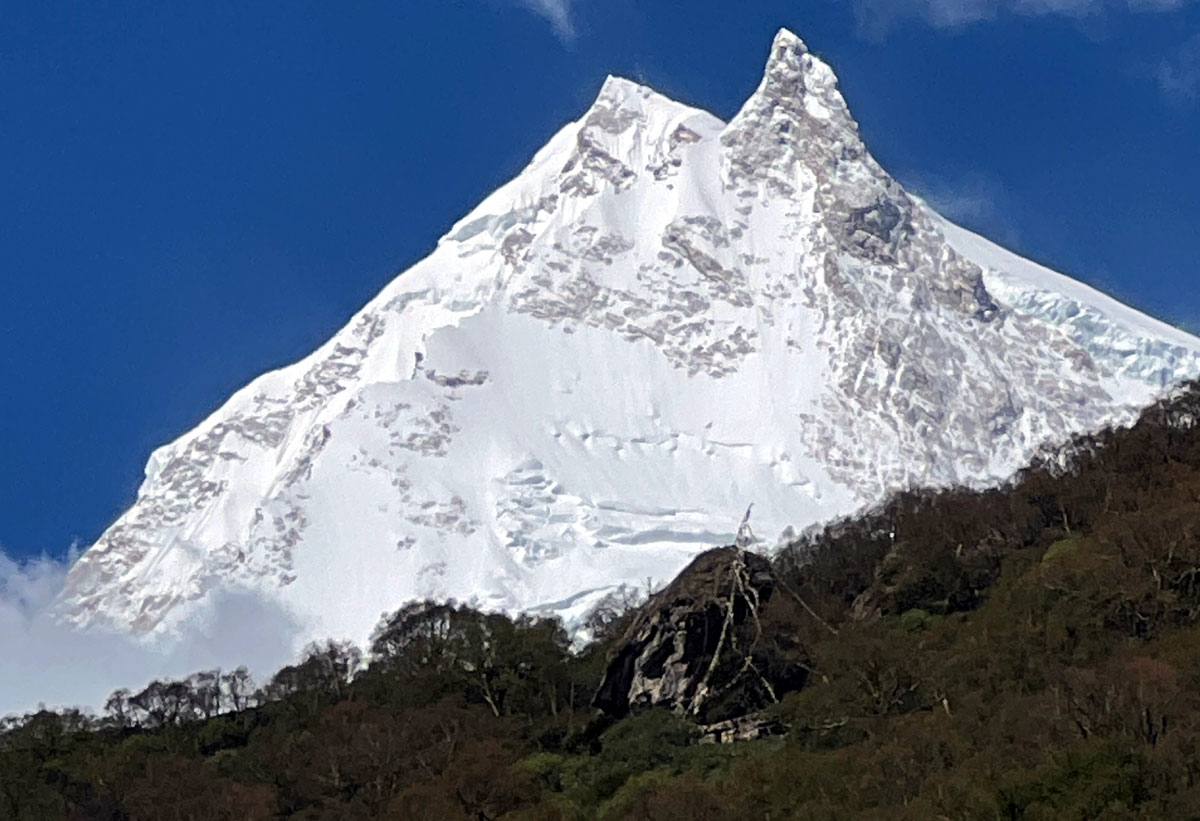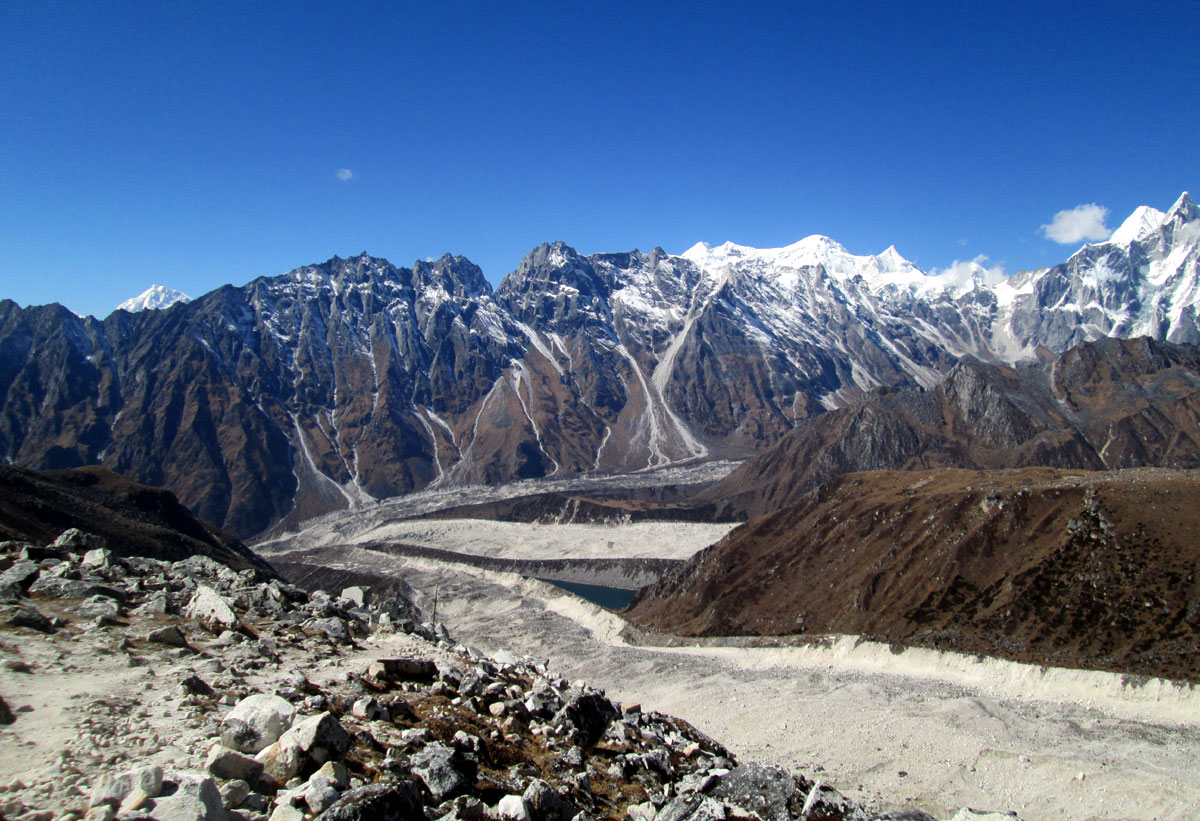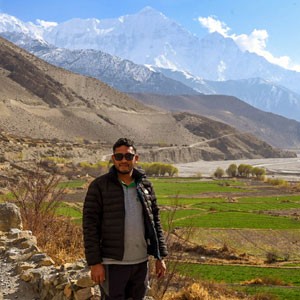Planning the Manaslu Circuit Trek in December 2025? While winter in Nepal’s Himalayas brings cold and snow, it also reveals peaceful trails, quiet villages, and stunning mountain views. This guide covers everything you need to know about trekking Manaslu in December - from weather and trail conditions to permits, gear, safety tips, and costs. Discover why this off-season trek is worth the challenge and how to prepare for it.
Manaslu Circuit Trek in December
Table of Contents
Why Trek the Manaslu Circuit in December 2025?
Most trekkers flock to Manaslu between September and November, hoping for clear skies and stable weather. By December, however, the trail thins drastically. Teahouses that remain open cater almost exclusively to hardened winter trekkers, lending a lodge-to-lodge experience that borders on the private. Imagine sipping hot tea by a wood-burning stove, watching snowflakes drift outside, or waking to a frozen world lit by a pale Himalayan sunrise.
In 2025, El Niño’s weak effects are predicted to spare the region from extreme precipitation, meaning that late November snows may settle into compact trails by mid-December ideal for trekkers who welcome chilly mornings and the crispness that only high-altitude winter can bring. Whether you’re chasing photographic opportunities, glittering ice formations, frozen waterfalls, and the crisp silhouette of Manaslu 8163m or simply yearning to test your mettle against a quieter, more contemplative route, December is the time to go.

Updated Permit Requirements for Manaslu Trek in December
Before lacing up your boots, you’ll need to secure two primary permits: the Restricted Area Permit (RAP) for Manaslu, available only through a registered trekking agency, and the Annapurna Conservation Area Permit (ACAP), since the lower section overlaps with the Annapurna Conservation Area. As of early 2025, the government has increased the RAP fee to USD 100 per week (pro rata for additional days), so budgeting around USD 120–140 for a 15-day trek is prudent.
The ACAP permit still stands at NPR 3,000 (approximately USD 23), plus NPR 1,000 for the TIMS card (USD 8). In December, officials are less hurried, but don’t postpone permission requests until the last minute as Nepal’s bureaucracy can still catch you off guard. Additionally, be aware that local authorities may require trekkers to join a licensed guide for winter treks; check with your agency in Kathmandu for the latest policy updates in late 2025.
What to Expect on the Trail in December - Manaslu Trek Highlights
Jagat to Deng : After passing through dense rhododendron and bamboo thickets, you’ll reach Deng, a modest settlement overlooking the Budhi Gandaki River. In December, expect morning frost on bamboo leaves and, occasionally, frozen stream crossings. Deng’s lodge owners often narrate local folklore: how, centuries ago, pilgrims first encountered Manaslu’s sacred peaks.
Lho and Samagaon : Lho’s hilltop gompa (monastery) houses 12-foot-high paintings of Padmasambhava, an excellent spot for acclimatization. From Lho, a short traverse brings you to Samagaon, where teahouses are heated by yak dung stoves. Samagaon, at 3,530m, becomes eerily silent in December except for occasional prayer bells. Imagine waking at dawn to watch the orange glow crest the colossus of Manaslu, listening to monks utter morning prayers.
Samagaon to Samdo : The trail narrows, and juniper bushes give way to stunted alpine grass. With fewer trekkers on the route, you might spot Himalayan tahr or blue sheep. In Samdo, a village of stone houses sits at the confluence of two glacial streams; the morning sun reveals intricate ice crystals on flat roofs. If you arrive early, hike up to the Samdo Phu Glacier viewpoint for panorama, just be prepared for knee-deep snow.
Dharmsala: Also called Yangrima, this unofficial base camp for Larke La is nothing more than a row of teahouses if they are open. In December, many lodges may shut; confirm in advance with your agency which guesthouses remain operational. A short side trip to the nearby ridge affords circumnavigating views of Kang Guru (6,981m) and Nyak (6,150m).
Crossing Larke La: Rising well before 4:30 AM ensures you’re on the pass by 9:00 AM, before the notorious afternoon wind gusts materialize. The ascent involves navigating snow cornices and occasional ice patches; crampons and an ice axe (and the know-how to use them) are non-negotiable. Upon reaching 5,160m, you’ll descend into a narrow gorge skirting the Larke Glacier an ethereal experience as wind-carved ice walls glow blue at dusk if you linger.
Bhimtang to Dharapani: Bhimtang is a rare winter waypoint often deserted except for nomadic herders and hardy guides. Come January 2025, local entrepreneurs installed solar panels to power modest tea houses, but in December 2025, electricity can still be patchy. After Bhimtang, descending along the Marshyangdi River warms temperatures dramatically, forest floors transition from frozen to damp, and you might catch the faint chatter of monkeys in bamboo groves.
.jpg)
Manaslu December Weather, Trail Conditions, and Safety Tips
December in the Manaslu region is characterized by clear skies, cold nights (temperatures at Larke La can plummet to –20°C), and potential for early winter storms. While major snowfall usually begins in January, mid-December can still see storm clouds funnel through the Tibetan plateau. Check with local Annapurna Conservation Area Project (ACAP) offices before departure for updated avalanche forecasts. On the trail:
- Trail Visibility: Snow-covered switchbacks can erase footprints within hours. Carry a GPS device or follow rope-fenced sections on steep slopes. Guides often carry handheld radios to communicate between parties, it is better to consider renting one.
- Altitude Sickness: As with any trek above 3,500m, acute mountain sickness (AMS) remains a serious threat. Make sure to include two full rest or short-hike days in Samagaon and Lho in your itinerary. Maintain a climb rate under 500m per day above 3,000m, and be prepared to turn back if severe symptoms arise.
- Avalanche Risks: Sections near Dharamsala, especially on the upper slopes of Larke La, can harbor corniced snowfields. Experience in reading snow conditions is vital.
- Hypothermia and Frostbite: December treks demand high-quality down jackets (preferably 800-fill), insulated gloves, and double-layered socks. Night temperatures in Samdo or Dharamsala can be –15 to –18°C; ensure your sleeping bag is rated to at least –25°C.
Essential Winter Gear Checklist for Manaslu Trek December 2025
Winter Gear Breakdown for Manaslu Trek
Clothing Layers:
- Base layers (moisture-wicking, merino/poly blend)
- Mid layers (fleece jackets, insulation pants)
- Outer shell (waterproof, breathable jacket and pants with DWR coating)
- Insulated down jacket (800-fill or greater) for camp
- Down or synthetic high-altitude pants for summit days
Footwear:
- Insulated, waterproof mountaineering boots (double boots recommended for Larke La)
- Mountaineering gaiters to prevent snow ingress
- Two pairs of thick wool or synthetic socks (plus thin liner socks to prevent blisters)
- Crampons compatible with your boots (12-point steel) and sturdy ice axe with leash
Camping and Sleeping:
- Four-season sleeping bag rated to –25°C or colder
- Insulated sleeping pad (closed-cell foam with inflatable top layer)
Safety and Navigation:
- GPS device with preloaded Manaslu Circuit map, plus physical map and compass
- Avalanche probe and shovel—if traveling with a guided group, confirm their avalanche training and gear; if independent, ensure full familiarity with rescue techniques
- First-aid kit emphasizing altitude medication (Diamox), painkillers, blister care, and altitude-specific items (Gamow bag if possible)
Miscellaneous Essentials:
- Headlamp with extra batteries (cold drains batteries faster)
- High-calorie snacks (chocolate, energy gels, nuts), since appetite often drops in extreme cold
- UV-protective sunglasses (category 4), since snow glare at 5,000m can harm eyes
- Sunscreen SPF 50+ and lip balm (winter sun still intense above 4,000m)
- Water purification tablets (iodine-based, since UV steri-sticks may underperform in low temperatures)
- Lightweight stove with fuel (liquid fuel stoves work better in subzero) and windscreen
Documentation and Finance:
- Hard copy of all permits, insurance papers (including helicopter evacuation coverage), photocopies stored separately
- Cash in small denominations (Nepalese rupees) as few ATMs are operate beyond Kathmandu; December sees limited electricity, so digital payments are almost nonexistent
Accommodation in December - Teahouse Experience in Winter
By December, many lodges along the Manaslu Circuit close or operate irregularly, firing up only when groups request service. In Jagat, Deng, and Namrung, basic stone-and-wood lodges usually remain open, but at Lho and Samagaon, confirm availability three to four weeks in advance. It’s common for a lodge owner to request a minimum group size; often four trekkers to keep their tea house functional. Facilities in high-altitude lodges shrink to bare-bones: a single stove room serves as kitchen, dining, and lounge. Bring a personal sleeping bag liner, as washed linens might not be available. Water often freezes; lodging owners heat it sparingly on wood or dung stoves, so be prepared for cold showers or sponge baths using boiled water.
Meals in December tend toward high-calorie comfort foods: dal bhat with extra oil, instant noodles with cheese, and local tsampa (barley flour) porridge. Be courteous with meal timings chiefly because daylight is limited. Dinner might be at 5:00 PM, after which the stove is extinguished to conserve fuel, so pack headlamps and extra snacks in case you arrive late.
Local Culture and Festivals in December - A Winter Perspective
Although fewer trekkers tread the Manaslu Circuit in December, the villages pulse with authentic cultural life. In Deng, observe Newar traders perched atop the ridge, stuffing Tshering and Kharkati traders’ yak caravans with dried meat and yak butter. In Samagaon, join monks at the Punggen Monastery for morning prayers, listen to their deep, resonant chants echoing through the valley. Winter is also yak migration season; at higher altitudes, you might witness herders leading small caravans of yaks and dzos to lower winter grazing grounds. Crucially, December trekkers support these isolated villages at a time when tourism nearly vanishes, your teahouse fees go directly into the local economy, fueling schools, health posts, and road repairs.
Health, Travel Insurance, and Emergency Support for Winter Trek
High-altitude conditions can deteriorate rapidly. Aside from AMS, be vigilant about frostbite—fingers and toes are the most vulnerable. A quick check: remove gloves periodically and wiggle fingers to ensure circulation. Regarding insurance, confirm your policy covers helicopter evacuation down to at least 2,000m, and note that winter rescues can be delayed if weather conditions are hazardous. Major trekking agencies in Kathmandu (e.g., Sacred Summits Treks & Expeditions) partner with Pokhara-based rescue services; ask your agency to share recent evacuation case studies so you understand typical response times in December. Lastly, carry a portable oxygen cylinder (1–2 L) for emergencies. Even if you never use it, having oxygen on hand can stabilize severe AMS cases until evacuation teams arrive.
Cost Breakdown and Budgeting for Manaslu Trek in December 2025
Permits and TIMS: RAP (USD 75, pro-rated for days beyond one week), ACAP (NPR 3,000), TIMS (NPR 1,000), total USD 180.
Guide and Porter (Mandatory in Winter): A certified guide costs about USD 25–30 per day inclusive of their food, lodging, and agency fees; a porter is around USD 15–18 per day plus tipping. For a 14-day trek, expect USD 600–700 for a guide and USD 300–350 for a porter, plus tips (USD 150–200 combined).
Teahouse Costs: Dorm bed in low villages (Jagat, Deng) is NPR 500–600 per night (USD 4–5), in high villages (Samagaon, Samdo) NPR 800–1,200 (USD 7–10), rising further at Dharamsala (NPR 1,500–2,000). Multiply by 15 nights → roughly USD 150–200 total. Meals average NPR 600–1,500 per sitting (USD 5–12) depending on altitude; assume USD 20–25 per day for three meals → USD 300–400.
Gear Rental/Acquisition: If you rent crampons, sleeping bags, and down jacket in Kathmandu, budget USD 50–100 for the duration. If buying, prices rise: mountaineering boots (USD 200–250), 800-fill down jacket (USD 250–300), insulated sleeping bag (USD 200+).
Transportation: Round-trip private jeep or microbus to Machha Khola and back: USD 170–220 per vehicle, typically shared by up to 7 trekkers. Bus options are cheaper (USD 10–15 per person each way) but can be canceled if weather or road conditions deteriorate.
Miscellaneous: Insurance (USD 100–150 depending on age and coverage), hot showers (NPR 300–500 per shower in high villages), hote showers, wifi, tea/coffee/snacks (USD 50-100 total).
Overall, a winter Manaslu trek in December 2025 costs roughly USD 1,500–3,000 per person, depending on gear needs and gratuities. If you already own gear and share a jeep, costs can edge closer to USD 1,000.
Top Tips for Trekking Manaslu Circuit in December
Flexibility is Key: December weather can shift quickly. Build a buffer day after Larke La to accommodate delays. Plan for optional side trips only if the weather holds steady.
Join a Small, Experienced Group: With fewer teahouses open, isolation can become a safety concern. Small guided groups (4–6 trekkers) ensure constant support without overtaxing lodges.
Leave No Trace: Winter landscapes are fragile. Even if trails are snow-covered, stick to established pathways and pack out all non-biodegradable waste. Teahouses in Samagaon and beyond have limited disposal capacity; carry zip-lock bags for trash until you descend.
Mental Preparation: Short days and cold nights can feel monotonous. Bring books, cards, or a journal. Embrace the quiet as this is your opportunity to reflect, free from the crowds of peak season.
Hydration Over Warmth: Staying hydrated thins blood and wards off altitude sickness. Even if drinking lukewarm water seems daunting, sip frequently. Insulated water bottles help prevent freezing.
Connect with Locals: Samagaon’s women’s weaving cooperative opens sporadically in winter, purchase handwoven shawls or prayer flags to support community livelihoods. A simple “Namaste” and a smile in local dialect can break ice literally and figuratively.

Conclusion - Why Manaslu in December Is Worth the Challenge
The Manaslu Circuit in December 2025 is not a trek for everyone. It’s a deliberate choice to trade convenience for introspection, warmth for exhilaration, and crowds for solitude. You’ll ascend creaking wooden ladders, suspended high above icy rivers, gaze at Manaslu’s sheer north face framed by frozen prayer flags, and navigate narrow cols carved by relentless wind. Each step in the snow is a step deeper into self-reliance: layering clothes, monitoring your breath at altitude, and adapting your pace to the mountain’s whims.
Yet when you finally stand atop Larke La fingers tingling, and lungs burning, you’ll feel an accomplishment few ever taste. The Himalaya in December seems to hush the world, offering a rare glimpse of winter’s unfiltered grandeur. If 2025 finds you in Kathmandu with this ambition in your heart, lace up your boots, check your gear, and embrace the challenge. The Manaslu Circuit awaits in all its frozen, breathtaking solitude.

